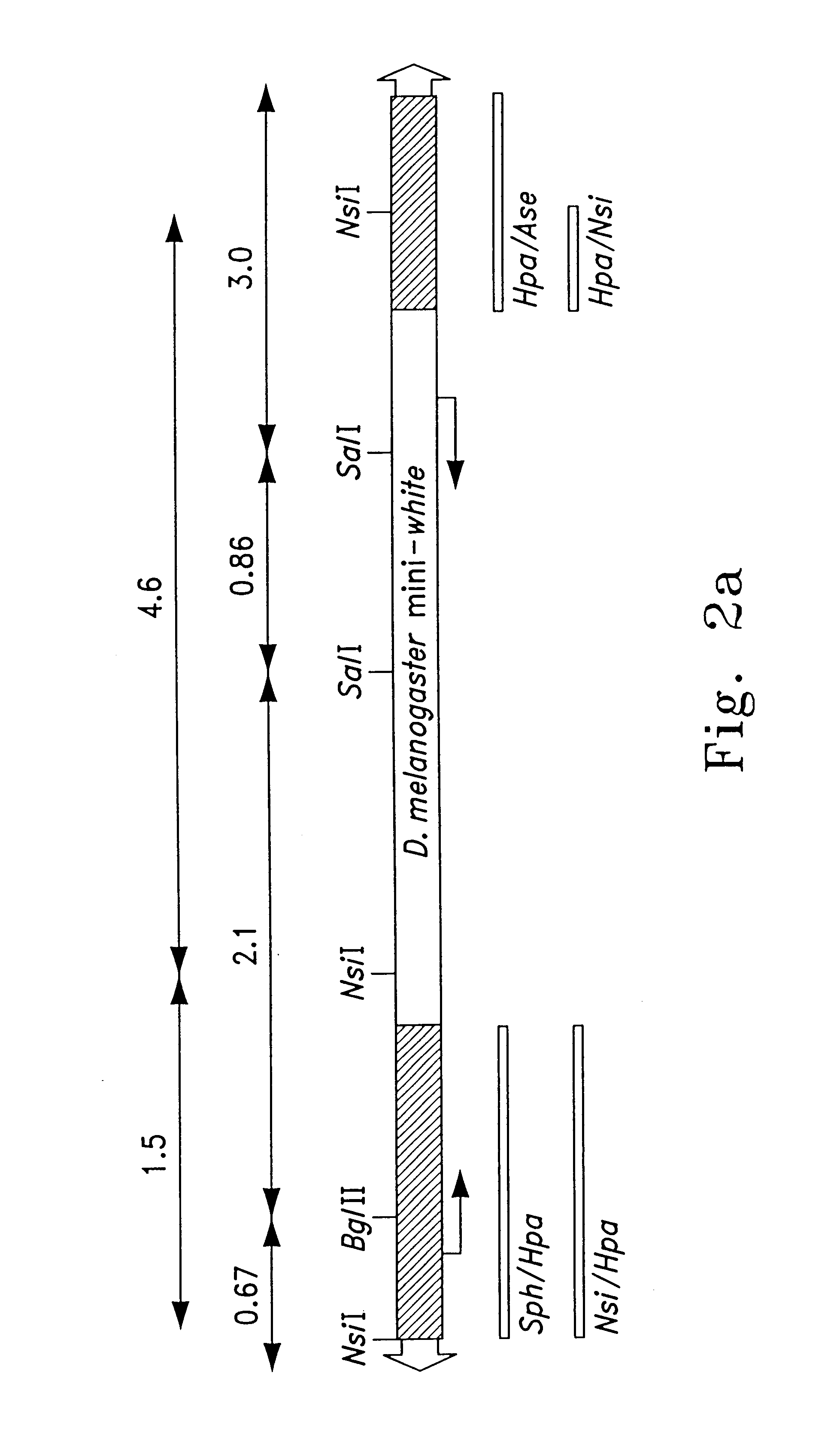PiggyBac transformation system
- Summary
- Abstract
- Description
- Claims
- Application Information
AI Technical Summary
Problems solved by technology
Method used
Image
Examples
example 2
Embryo injections used standard procedures (Rubin & Spradling, Science, Volume 218, 348-353, 1982; herein incorporated by reference) with dechorionation achieved either manually or by 1.6% hypochlorite solution followed by about 2 washings in approximately 0.02% Triton-X 100 in water. Eggs were placed on double-stick tape, desiccated in room-air for about 10-15 minutes and submerged under Halocarbon 700 oil. Injections followed standard Drosophila microinjection procedures (Rubin and Spradling, Science, Volume 218, 348-353, 1982; herein incorporated by reference). DNA mixtures had vector:helper concentrations of about 600:400 .mu.g / ml, respectively, in injection buffer (approximately 5 mM KCl; approximately 0.1 mM sodium phosphate; at about pH 6.8). Injected eggs were placed in an oxygenated and humidified tissue culture chamber at about 22-23.degree. C. for about 3-6 hours, and phsp-pBac injected eggs were heat shocked at about 37.degree. C. for about one hour. Hatched larvae were ...
example iii
Southern hybridization was performed to verify genomic transposition of the piggyBac vectors. Approximately 5-10 .mu.g of genomic DNA was digested with indicated restriction enzymes and separated on about 0.8% agarose gels. DNA was stained with ethidium bromide, blotted to nylon filters and immobilized by ultraviolet irradiation. Hybridization probes were labeled with [.sup.32 P]-dCTP by random priming (Gibco BRL) according to the manufacturer's specifications. Probe DNA was generated from indicated piggyBac restriction fragments (see below) that were separated from p3E1.2, or the entire egfp gene from pEGFP-1 (Clontech) by agarose electrophoresis and gel-elution. Hybridizations were performed in phosphate buffer, approximately pH 7.5; about 1% BSA; about 7% SDS at about 65.degree. C. with an initial wash in about 2.times.SSC; about 0.2% SDS at about room temperature and about two washes in about 1.times.SSC; about 0.1% SDS at about 55.degree. C. for approximately 30 minutes. Autora...
example iv
To verify that piggyBac-mediated chromosomal transpositions had occurred, insertion sites were isolated by inverse PCR from sublines F1-2, M17-4 and M31-6, all having single integrations. Inverse PCR was performed as described previously (Handler et al., 1998, supra; herein incorporated by reference) using HaeIII digestions for 5' and 3' junctions and MspI digestion for 3' junctions. After about 4 hours digestion, restriction fragments were circularized by ligation at about 16.degree. C. for about 16 hours. PCR was preformed on the circularized fragments by using primer sequences in opposite orientation within the piggyBac restriction site and terminus for each junction. For the 5' junction, the forward primer (572F) 5'-TCTTGACCTTGCCACAGAGG-3' (SEQ ID NO 2) and reverse primer (154R) 5'-TGACACTTACCGCATTGACA-3' (SEQ ID NO 3) were used. For the 3' junction the reverse primer (2118R) 5'-GTCAGTCCAGAAACAACTTTGGC-3' (SEQ ID NO 4) and the forward primer (2385F) 5'-CCTCGATATACAGACCGATAAAAACA...
PUM
| Property | Measurement | Unit |
|---|---|---|
| Fraction | aaaaa | aaaaa |
| Fraction | aaaaa | aaaaa |
| Frequency | aaaaa | aaaaa |
Abstract
Description
Claims
Application Information
 Login to View More
Login to View More - R&D
- Intellectual Property
- Life Sciences
- Materials
- Tech Scout
- Unparalleled Data Quality
- Higher Quality Content
- 60% Fewer Hallucinations
Browse by: Latest US Patents, China's latest patents, Technical Efficacy Thesaurus, Application Domain, Technology Topic, Popular Technical Reports.
© 2025 PatSnap. All rights reserved.Legal|Privacy policy|Modern Slavery Act Transparency Statement|Sitemap|About US| Contact US: help@patsnap.com



